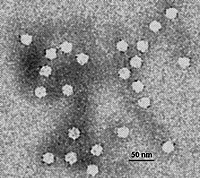
Photo from wikipedia
PurposeTo characterize new molecular factors implicated in a hereditary congenital facial paresis (HCFP) family and otosclerosis.MethodsWe performed exome sequencing in a four-generation family presenting nonprogressive HCFP and mixed hearing loss… Click to show full abstract
PurposeTo characterize new molecular factors implicated in a hereditary congenital facial paresis (HCFP) family and otosclerosis.MethodsWe performed exome sequencing in a four-generation family presenting nonprogressive HCFP and mixed hearing loss (HL). MEPE was analyzed using either Sanger sequencing or molecular inversion probes combined with massive parallel sequencing in 89 otosclerosis families, 1604 unrelated affected subjects, and 1538 unscreened controls.ResultsExome sequencing in the HCFP family led to the identification of a rare segregating heterozygous frameshift variant p.(Gln425Lysfs*38) in MEPE. As the HL phenotype in this family resembled otosclerosis, we performed variant burden and variance components analyses in a large otosclerosis cohort and demonstrated that nonsense and frameshift MEPE variants were significantly enriched in affected subjects (p = 0.0006–0.0060).ConclusionMEPE exerts its function in bone homeostasis by two domains, an RGD and an acidic serine aspartate-rich MEPE-associated (ASARM) motif inhibiting respectively bone resorption and mineralization. All variants associated with otosclerosis are predicted to result in nonsense mediated decay or an ASARM-and-RGD-truncated MEPE. The HCFP variant is predicted to produce an ASARM-truncated MEPE with an intact RGD motif. This difference in effect on the protein corresponds with the presumed pathophysiology of both diseases, and provides a plausible molecular explanation for the distinct phenotypic outcome.
Journal Title: Genetics in Medicine
Year Published: 2018
Link to full text (if available)
Share on Social Media: Sign Up to like & get
recommendations!